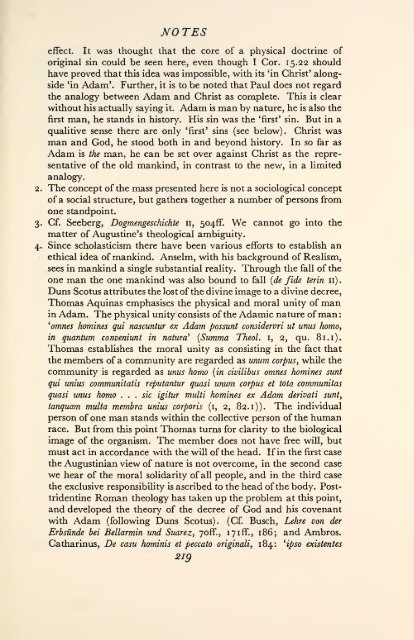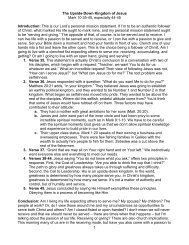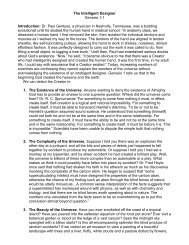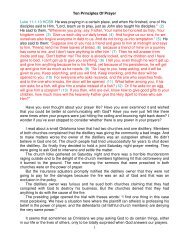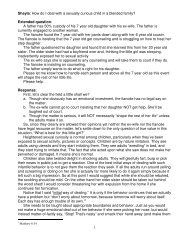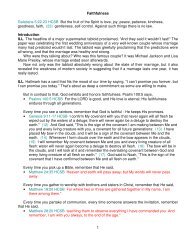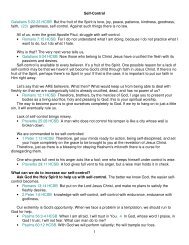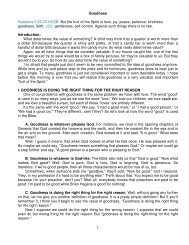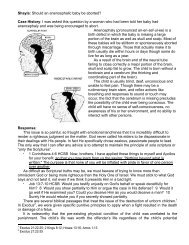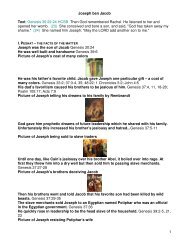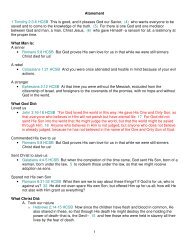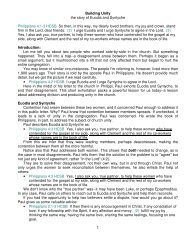Communion of saints
Communion of saints
Communion of saints
You also want an ePaper? Increase the reach of your titles
YUMPU automatically turns print PDFs into web optimized ePapers that Google loves.
MOTES<br />
effect. It was thought that the core <strong>of</strong> a physical doctrine <strong>of</strong><br />
original sin could be seen here, even though I Cor. 15.22 should<br />
have proved that this idea was impossible, with its 'in Christ' alongside<br />
'in Adam'. Further, it is to be noted that Paul does not regard<br />
the analogy between Adam and Christ as complete. This is clear<br />
without his actually saying it. Adam is man by nature, he is also the<br />
first man, he stands in history. His sin was the 'first' sin. But in a<br />
qualitive sense there are only 'first' sins (see below). Christ was<br />
man and God, he stood both in and beyond history. In so far as<br />
Adam is the man, he can be set over against Christ as the representative<br />
<strong>of</strong> the old mankind, in contrast to the new, in a limited<br />
analogy.<br />
The concept <strong>of</strong> the mass presented here is not a sociological concept<br />
<strong>of</strong> a social structure, but gathers together a number <strong>of</strong> persons from<br />
one standpoint.<br />
Cf. Seeberg, Dogmengeschichte 11, 504ff. We cannot go into the<br />
matter <strong>of</strong> Augustine's theological ambiguity.<br />
Since scholasticism there have been various efforts to establish an<br />
ethical idea <strong>of</strong> mankind. Anselm, with his background <strong>of</strong> Realism,<br />
sees in mankind a single substantial reality. Through the fall <strong>of</strong> the<br />
one man the one mankind was also bound to fall (de fide terin 11)<br />
Duns Scotus attributes the lost <strong>of</strong> the divine image to a divine decree,<br />
Thomas Aquinas emphasises the physical and moral unity <strong>of</strong> man<br />
in Adam. The physical unity consists <strong>of</strong> the Adamic nature <strong>of</strong> man<br />
'omnes homines qui nascuntur ex Adam possunt considervri ut unus homo,<br />
in quantum conveniunt in natural {Summa Theol. 1, 2, qu. 81. 1).<br />
Thomas establishes the moral unity as consisting in the fact that<br />
the members <strong>of</strong> a community are regarded as unum corpus, while the<br />
community is regarded as unus homo {in civilibus omnes homines sunt<br />
qui unius communitatis reputantur quasi unum corpus et tota communitas<br />
quasi unus homo . . . sic igitur multi homines ex Adam derivati sunt,<br />
tanquam multa membra unius corporis (1, 2, 82.1)). The individual<br />
person <strong>of</strong> one man stands within the collective person <strong>of</strong> the human<br />
race. But from this point Thomas turns for clarity to the biological<br />
image <strong>of</strong> the organism. The member does not have free will, but<br />
must act in accordance with the will <strong>of</strong> the head. If in the first case<br />
the Augustinian view <strong>of</strong> nature is not overcome, in the second case<br />
we hear <strong>of</strong> the moral solidarity <strong>of</strong> all people, and in the third case<br />
the exclusive responsibility is ascribed to the head <strong>of</strong> the body. Posttridentine<br />
Roman theology has taken up the problem at this point,<br />
and developed the theory <strong>of</strong> the decree <strong>of</strong> God and his covenant<br />
with Adam (following Duns Scotus). (Cf. Busch, Lehre von der<br />
Erbsunde bei Bellarmin und Suarez, 7<strong>of</strong>f, 1 7ifT., 186; and Ambros.<br />
Catharinus, De casu hominis et peccato originali, 184: 'ipso existentes<br />
219


